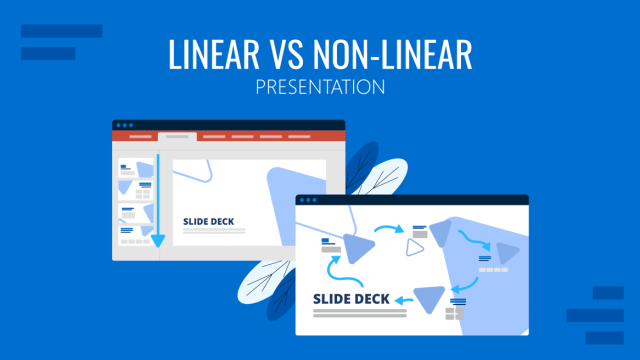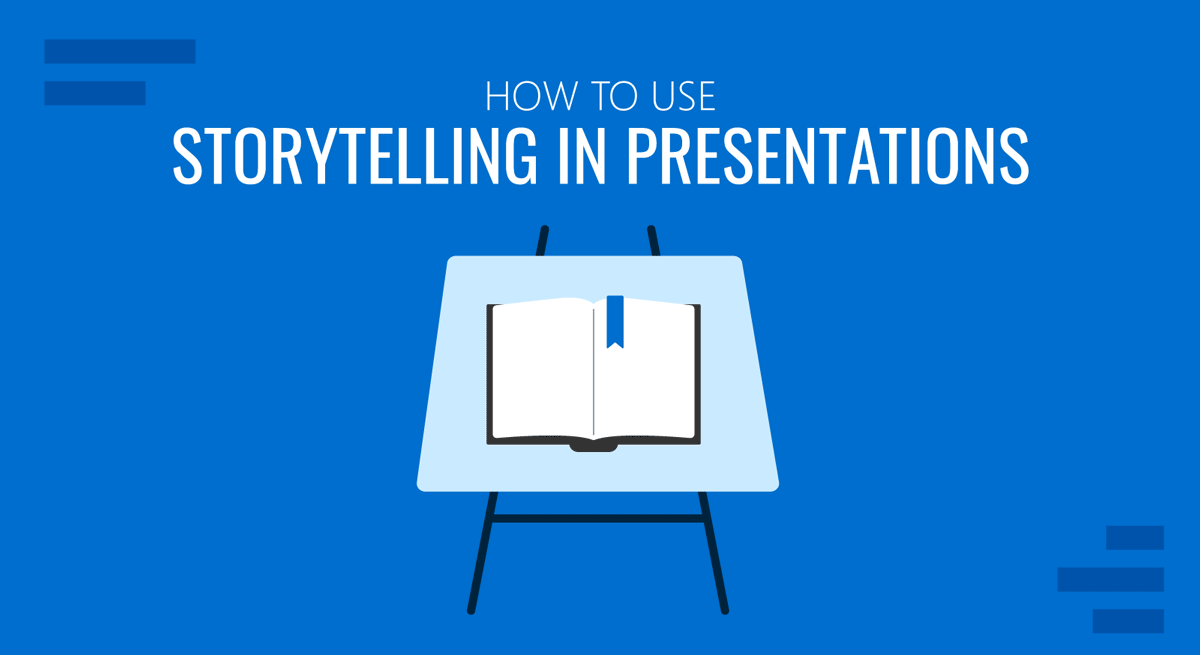
Presentations happen daily in corporate meeting rooms, hybrid sessions, fully remote summits, seminars, and weekly check-ins. What was once referred to as “Death by PowerPoint” has become “This could have been an email.”
In a survey about the current work state, 91% of workers admitted that they daydream during meetings. They’re creating stories in their minds because they’re not concentrating on the meeting or the presentation on their screen.
Nobody wants meetings that go nowhere; aim for efficiency and less time wasted. Mindful communication and some good old storytelling techniques are the best ways to reach that goal. On the other hand, stories present a different point of view on how to tell a story to an audience and disclose large chunks of data without losing the audience’s interest.
Research by the Journal of Neuroscience (2019) discusses the importance of using storytelling in business presentations to disclose information to the public in a more accessible format. Our brains are wired to process stories more effectively than raw data or facts. When we hear a story, our brains release oxytocin, a hormone associated with empathy and trust, which helps us connect emotionally with the speaker and the content. Hence, the importance of curating the script to deliver your story to the audience as stories have the power to inspire, worry, heal, and even to attract a negative impact, as suggested by the American Psychological Association.
You can harness this phenomenon in your presentations regardless of their scope. In this guide, we share storytelling techniques you might not have thought of and reinforce the classics with new ideas. This article is for weekly report presenters, sales agents presenting to clients daily, and anyone looking to improve their PowerPoint storytelling training skills.
Let’s get started.
Table of Contents
- The Power of Storytelling
- Incorporating Storytelling into Corporate Presentations
- Case Study of Storytelling in a Corporate Presentation
- The Power of Visual Metaphors and your Stories
- Overcoming Challenges in Storytelling for Corporate Presentations
- Conclusion
- Sources
The Power of Storytelling
Communication through storytelling is the intersection between informing, connecting, and persuading. Stories have been the foundation of human connection since the beginning of human history. Before the advent of written language, history was shared through spoken storytelling. Then came books, plays, movies, and storytelling modalities that united people through communication.
Findings demonstrate that storytelling is essential for presenting innovative ideas and gaining interest and support from others. In any scenario, from academic to corporate, when people are engaged with a story, they are more likely to pay attention, ask questions, and participate in the presentation. This engagement can lead to better outcomes for the presenter and the audience.
Storytelling breaks the ice through empathy and relatability. Short, rapid-fire associations help overcome communication obstacles and connect the speaker to the audience, especially when the presenter doesn’t know the audience personally.
Imagine that you’re about to present to a college audience of students, scholars, and teachers. Tap into what they can all relate to: the room you’re in, the event you’re all attending, the weather, and create a quick story or comment about it. If you’re a visual storytelling master, tie it into your presentation’s intro.
Benefits of Using Storytelling in Presentations
Stories motivate. It’s what they’re most appreciated for. Stories help people understand complex ideas or data by providing context, relatability, and a structure familiar to the human brain.
Using stories improves the memorability and strength of the message while creating a connection between the speaker and the audience. Practicing storytelling in presentations increases confidence in the speaker and, therefore, the audience.
Research by Stanford University suggests that people remember stories better than simple facts, and incorporating stories into presentations can lead to better retention. A story also has the potential to turn a presentation into a conversation, opening up the possibilities of communication even further.
Incorporating Storytelling into Corporate Presentations
The average corporate worker is involved in presentations at least twice a week. Incorporating storytelling into those presentations, no matter how small, improves efficiency and results.
But simply telling a random joke isn’t going to cut it; your content has to be tailored to the audience, finding the right balance between story and data and incorporating structures for storytelling slides, and visual, textual, and auditory storytelling techniques. Storytelling techniques span from small touches like quotes, GIFs, or memes to a full-scale story spanning every presentation slide.
Corporate Storytelling is the branch by which we apply storytelling techniques to business environments, which can happen in the format of writing mission & vision statements, presentations, marketing, sales proposals, product design, etc. Its company-wide application ensures that communication is clear across all levels but also reflects on overcoming obstacles with real-life applications of what the corporation is producing.
Understanding the Audience and Tailoring the Story to their Interests and Needs
Audiences can be vertical or horizontal. Vertical audiences are people with more or less knowledge than you. Horizontal audiences have the same knowledge as you. This distinction matters because it directs your decision-making toward the terminology and story arc you incorporate into a presentation.
For example, the communication is horizontal in a small meeting with your peers where you present a roadmap for a project launch. You can use industry jargon freely because they’ll all understand. Here’s a possible storytelling technique for a roadmap presentation.
- Create avatars for each team member with a funny accessory or cool background. Place each avatar on their tasks and move them along every week when you have check-ins. Make it fun and build a story around it. Your plan succeeds if people are talking about it outside the meeting room.
In a hybrid orientation session with new employees and interns. There’s less room for jokes than in a horizontal team environment. Use storytelling to train and inspire 50+ people in a hybrid setting.
- Open the presentation with real success stories of employees who came into the company and thrived over time. Don’t just show this employee at work doing tasks; also show them in situations where they enjoy themselves and feel a sense of accomplishment.
- Incorporate dialogue simulations into the presentation. Choose participants randomly and ask them to have a guided conversation about something they might encounter at work.
- Separate the audience into break-out rooms and ask participants different “what if” questions. Afterward, have a group discussion and create possible user stories from the answers.
- Your storytelling plan succeeded if at least ¾ of the audience participated and there was some laughter and enjoyment during the session.
Presentations to large audiences, like keynote speeches and TED talks, are the easiest to add storytelling techniques to. Communication is typically a combination of vertical and horizontal in these cases. Here are some PowerPoint storytelling training ideas:
- Tell a story that happened to you that ties into the content you’re sharing. Use unifying and stringing techniques to bring the idea from the story to the content and vice versa.
- Separate the presentation into parts and tell one story per section. Select tales that people can relate to, like overcoming obstacles, reaching goals, and surviving traumas. Everyone can relate to those.
Data Storytelling
Some scenarios present a particular challenge for presenters: how to implement storytelling if the presentation heavily relies on data? Certainly, text cannot replace factual information, not visual metaphors, so in such cases, we highly recommend you follow a methodology like the one exposed in our article about data storytelling.
Storytelling Structures for Crafting a Compelling Story for a Corporate Presentation
A storytelling structure will always help create better presentations by captivating your audience’s attention and engaging them more deeply. Sequential steps build a sense of suspense, transforming mere information into a compelling narrative that resonates. By learning how to structure your presentation like a story, you can effectively convey your message and leave a lasting impact. Here are some of the most effective storytelling techniques tailored to their specific scopes:
SCQA – Situation, Complication, Question, Answer
The SCQA framework is an essential tool for analytic storytelling in presentations. It’s a practical tool in business communication that audiences relate easily to. As it follows a logical flow to present a situation and the steps to its resolution, it is one of the easiest methodologies for implementing storytelling in presentations. In our detailed case study, we shall expose a step-by-step process for applying this framework.
These are the sections of SCQA:
- Situation
- Complication
- Question
- Answer
We introduce this case to quickly represent this model: A furniture exporter has found customer complaints regarding the parcel delivery system. Using the SCQA, they can pinpoint the story behind the situation: some third-party vendors don’t use the platform-approved parcel delivery service, which implies an extra charge for the vendors, and opt instead for their own systems. In turn, some orders get lost, and customers cannot retrieve information on the shipping status until it’s delivered.
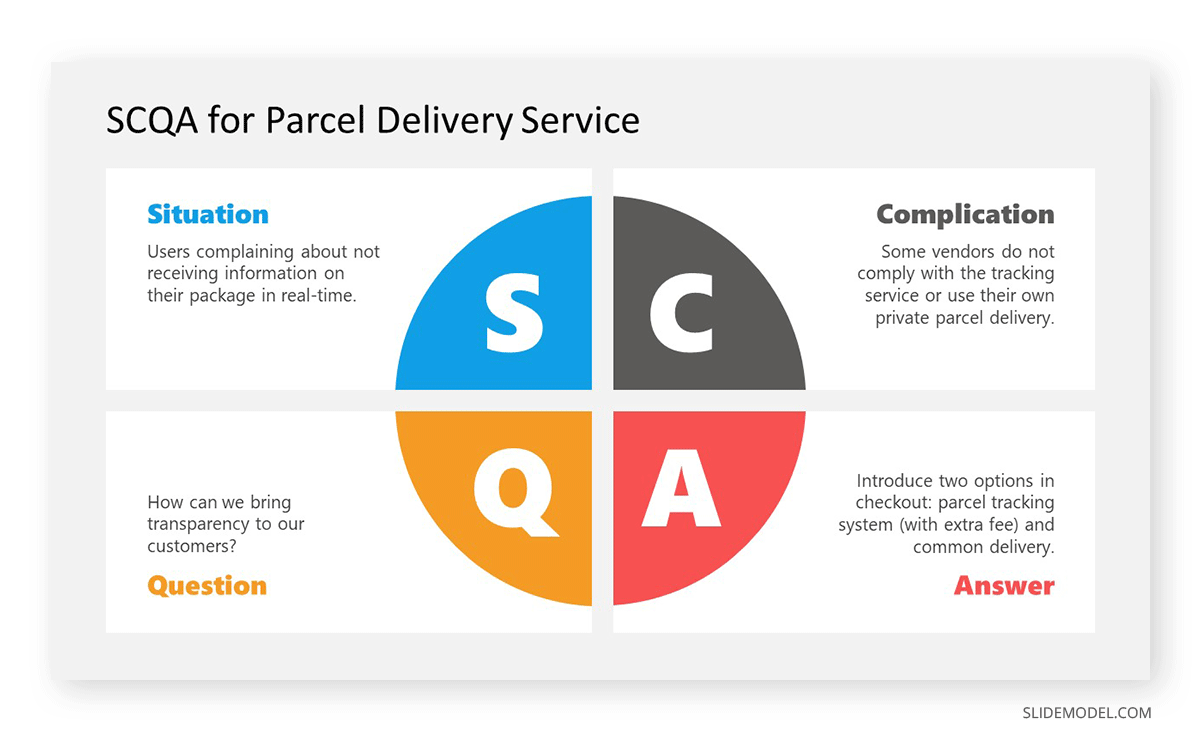
SCQA offers the advantage of helping presenters to structure complex concepts in a story format, which benefits situations like technical or scientific presentations as jargon can be reduced to easy-to-relate life situations.
Story Mountain
The story mountain or story arch is a literary structure for telling stories. It also works for medium size business presentations. It is a visual metaphor that illustrates the path to transit a mountain, from one point to the other end, and lists key points along the road, as well as the differences in the pace for each stage.
These are the stops in a story mountain:
- Opening: Start by introducing the main characters, the setting, and the context of your story, which, in terms of business situations, reflects the company, product, or service, then the problem your organization intends to address.
- Build-Up: This is the core problem to resolve. It should be disclosed in a manner that builds expectations and drives interest from the audience on which solutions are proposed and how they will work.
- Climax: The Climax can also be interpreted as an inflection point by which a direction change is introduced after an action is taken. This can be represented in the form of speaking about a strategic management shift that led your company into a successful path or an innovative solution later presented as a product or service that solves the core problem.
- Resolution: In this section, we illustrate how the core problem is solved due to the selected solution that arose from the Climax stage. Using testimonials is a great method to validate your authority on the topic and break the barrier between theoretical models and actual solutions. Other alternatives can come from case studies or introducing fact-based data.
- Ending: We conclude the story mountain structure by summarizing the key takeaways on the path to the mountain and highlighting how the organization solved the problem. Implement CTAs in this section, as it is where you should encourage prospective buyers to acquire your product/service. In the case of academic/scientific presentations, list down your contact information for possible collaboration projects.
We can showcase this model with a case like this: A manufacturing company producing paint cans is looking to implement production monitoring software on its shop floor. The aim is to increase efficiency, track real-time production, and better understand error codes.
- Opening: The company acknowledged its production needed more efficient, identifying hidden gems in their production process. They decided it was time to implement production monitoring software to take its production rates to new levels.
- Build-Up: As the company looks for different technology solutions, it can categorize the options offered by factors such as cost, features, and ease of implementation. They also ran an audit to get insights on which technology suits their production line the best.
- Climax: After a careful evaluation, the company chose a production monitoring software solution within its needs and budget. They opted to run a pilot on a limited number of machines, comparing the output results after 3 months. The implementation phase is handled by the software provided in terms of software, access points, and hardware required.
- Resolution: Over the first three weeks, the company observed significant improvements in its production process. They could locate bottlenecks that hindered the throughput rate, making the required changes to address them. This led to increased efficiency and brought cost-saving benefits to the company.
- Ending: The production monitoring software became an integral part of the company’s daily operations, influencing when maintenance tasks should be scheduled, providing insights about hidden production potential, and helping operators understand the consequences of each action taken more clearly. Due to the quick implementation process and the reports on cost-savings, especially from the scrap count reduction and energy-saving perspective, the company opted to install this production monitoring solution across all machines on the shop floor.
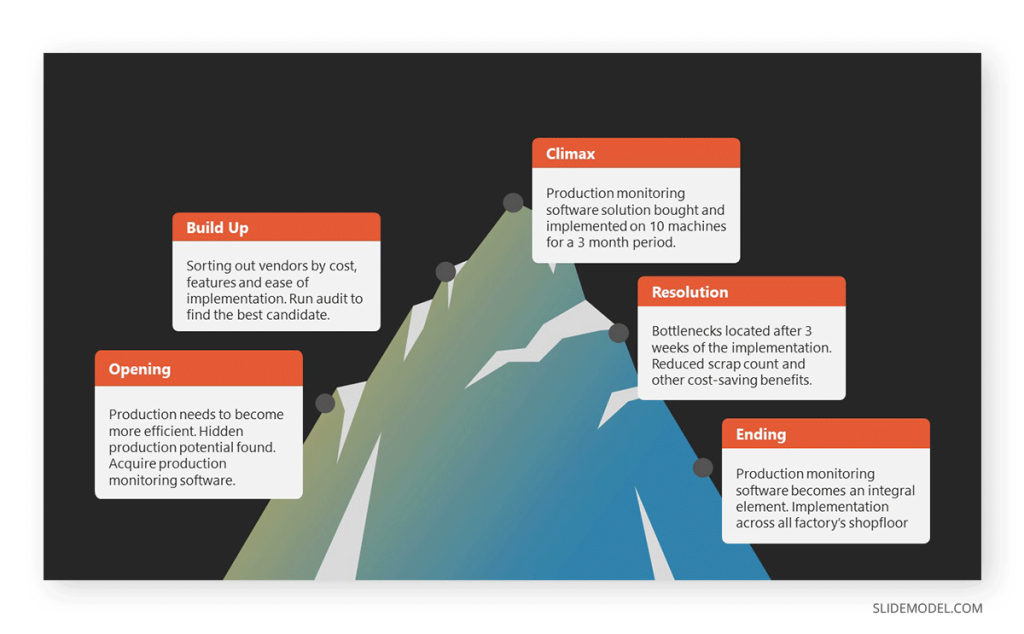
The Hero’s Journey
The Hero’s Journey is a storytelling technique that fits neatly into a long-form presentation or keynote speech. This framework became popularized by Joseph Cambell’s book “The Hero with a Thousand Faces,” it’s longer than the previous examples and can get quite elaborate. We can identify these sections in the Hero’s Journey:
- The Call to Adventure: The challenge/opportunity that initiates the path to the journey.
- Resisting the Call: The hero’s inner struggle to embark on the journey out of fear of failure or inadequacy.
- Meeting the Mentor: The encounter between the hero and a wise figure who provides advice on the journey.
- Crossing the Threshold: Moving from the comfort zone into the “Unknown,” walking into danger or uncertainty.
- Quests, Allies, and Enemies: The hero must transit obstacles and interactions to gather experience to face the key challenge of its journey.
- Approaching the Cave: In this stage, the hero faces the story’s main conflict.
- The Abyss: Where the hero experiences an internal crisis, inducing a transformation as it faces its deepest fear or a life-or-death choice.
- The Reward: After emerging victorious from The Abyss, our hero gains a valuable element (tangible or not) relevant to transit the rest of the quest.
- The Road Home: This stage represents the path back to their daily life, but finds new obstacles or challenges.
- The Rebirth: A final challenge emerges, where the hero is confronted with its greatest fear and must put all the knowledge to the test. This point showcases how much the hero has truly changed throughout the journey.
- Return: The hero is now back in its ordinary life, with the gained knowledge and a better understanding of the world. Now, that newfound knowledge is applied to benefit others.
That is a basic outline of the steps to cover in this road. If you wish to know more about this storytelling technique, we recommend you check our guide on The Hero’s Journey and its application.

Practical Techniques to Improve Storytelling in Presentations
Some presentations encompass various styles, functions, and objectives, each catering to specific communication goals. Internal and external presentations serve distinct purposes, requiring tailored approaches to effectively convey information. To enhance your storytelling prowess within presentations, here are some ideas that incorporate PowerPoint storytelling examples:
On Presenting Projects, Plans, Reports, etc.
Suppose you regularly present plans, project roadmaps, and reports to higher management. In that case, you can tap into what you intend to produce from the project and craft a success story, presenting the winning moments and obstacles your organization had to transit. Say, for example, a laptop manufacturer is presenting their newest model release plan. One of the main points to highlight in the marketing strategy is why this model is a flagship for the company. Well, since the product is due to be released in Q3 2023 and there were major differences in previous laptop designs by this company, the marketing team can build a narrative on how the Pandemic affected the initial design they had in mind due to the microchip shortage, the restrictions to work in shopfloor, and how they were presented with a new paradigm in terms of work. Those learnings were applied after noticing what customers needed regarding power and portability to work from anywhere in the world, not just a shared office. And that’s the background why this new laptop model is the solution for digital nomads and a brand new concept in the company’s strategy.
Introducing an Ideal Persona
For OKR sessions with newer employees, tell stories to inspire team members to feel invested in their objectives and key results. You can create one “ideal employee” model and craft a narrative around it to present common challenges, what objectives to aim for, and the benchmarks by which the company shall measure the new employees’ success rate. Express how this “ideal employee” came to the company fresh out of university, heading for a trainee role. How asking the mentors for advice helped the employee better understand their strengths and weaknesses and how to adapt them to perform at a greater level. Then, you can use this same narrative to cultivate the constant-learning mindset, as the “ideal employee” joined for extra-hours workshops that coach how to work with new frameworks, a well-paid sacrifice as it helped the employee to land an in-company promotion in less than 1 year. Use examples of other teams in the company and expose how they overcame new challenges or set new success metrics by collaborating as a team while staying true to your company’s mission & vision.
Strategies for Sales Meetings
Your best storytelling tactic for those presenting during external meetings like sales and proposals is the trusty “get to know your audience” technique. If it’s a big group, study the average person in attendance and direct your stories toward them. For smaller groups, research the client and mention things they’re interested in. Tie it into your presentation with stories, analogies, and metaphors. As an example of this tactic, let’s place ourselves in a sales professional’s shoes, presenting robotic vacuums to a group of investors and guaranteeing higher profits than they would make if investing in competitor brands like iRobot. The sales professional must gather information about the audience’s background, their individual investing profile, which projects similar to this product caught their interest, their expected ROI, and their threshold for risk. Then, the sales professional has to craft a narrative that attends to the needs of the average member in the meeting, with juicy details to spike the interest of the best 3 potential investors in the room. You can ask then what happens if there’s a conflict of interest in contrasting expectations. Step 1 is to stay true to your facts: do not present information your product or service cannot produce. Step 2 is to debate which position is more favorable to your interests and who is your ideal investor candidate. Step 3 is to calmly expose the facts that may drive the interest away from one/several investors and how your proposal aims to solve the problem in a different format than they expected. If, by chance, no consensus is reached, move towards Step 4, which is thanking the investors for their time and wishing that you can reach a business deal in another project.
Repurposing Customer Testimonials
In some cases, users crave tangible results from an innovative product. Talk to the customer satisfaction team at the company and ask them to tell you stories from the customers they talk to. Take notes of those experiences, remembering to write down the name in case you opt to cite a customer and need to ask for permission.
By working with your customers’ testimonials, your organization can learn about flaws your product or service may present. Such information can later be repurposed as the ground research of a new product line and even be used in the product presentation as a punch line when to introduce “Why did we create this product?” – it is a powerful resource to count with, and automatically validates your efforts by working on suggestions made from real-life customers on what they expect from a product or service.
This approach is also used in the format of surveys held by the customer satisfaction team, as we count on valid insights to work from.
Creating a Dialogue
Turn the presentation into a conversation. Incorporating storytelling into a conversation can feel more manageable than in a speech. This process can be done by following these steps:
- Simplify the language: Avoid any unrequired jargon when transforming the presentation into a conversational format. If you must use industry-exclusive terms, introduce them in the context and with an explanation as if speaking with a colleague. Overly format language should be discarded as the aim is for a conventional business conversation, as it would happen in a coffee break during an event.
- Structure the narrative: Make it a back-and-forth conversation where questions and comments can be added by any of the two interlocutors (the presenter and, in this case, the audience). Write down any aspect of the conversation that you feel might be left out if you don’t follow a strict outline.
- Use examples: As you would in any normal conversation, have some references at bay. Working with your case study in the presentation as an example can help in most cases, as you are already familiar with the ins and outs of that example. If not, opt for an example that is relevant and easy to structure for your talk.
- Be adaptable: It is not a presentation format but a more relaxed take on delivering a topic. With this, we imply unexpected changes can emerge like a member of the audience raising a series of consecutive questions or making it a lengthy monologue to express an idea. Go with the flow and only return to your speech if you divert too much from your intent.
- Highlight key points: Don’t dwell too much on specific details that may consume much time. Instead, push the key points into the conversation early on so you can reference them later as the conversation goes on.
Case Study of Storytelling in a Corporate Presentation
A software provider for the retail industry, TechEase, seeks to win a large contract from a potential client, a major retail chain, to implement a new inventory management system. The client, MoreIsLess, has expressed interest in TechEase’s software but has yet to make a final decision.
TechEase knows they are competing against several other software providers and must make a compelling sales presentation to set them apart.
First, the TeachEase team concretizes the client’s pain points to use them as a basis for a compelling story. TechEase must show how its software will meet the requirements to ease the client’s unique pain points.
- MoreIsLess needs an inventory management software solutionthat is more effective than the one they use now.
- The current software is unstable and is constantly making employees frustrated.
- It has also created issues with inventory data, making the company lose clients from its e-commerce platform due to undelivered orders and product sorting and packaging mistakes.
- MoreIsLess managers have previously had a negative experience with a software implementation project and are hesitant to take on another project that could potentially disrupt their operations.
- The client is concerned about the software’s complexity and whether it would be easy for their employees to use.
To address these challenges, TechEase’s sales team develops a sales story that will resonate with the client. One easy way to understand this problem is by implementing a metaphor. In this case, TechEase interprets the inefficiency in the system used by MoreIsLess as a bottleneck problem, given that new orders are added to the queue. However, unresolved/failed orders still hang there, altering the inventory data. In graphical terms, it resembles a car jam on a high-traffic road, where at a certain point, all elements get stuck.

Using the SCQA framework, the team sets up a structure for their sales presentation with the client company. They’ll build a compelling story with this as the foundation. The slides follow this outline and the structure for a sales presentation. Our SCQA Slides Template for PowerPoint is used to illustrate this case.
- Situation = MoreIsLess needs an inventory management software solution that will be more effective than now.
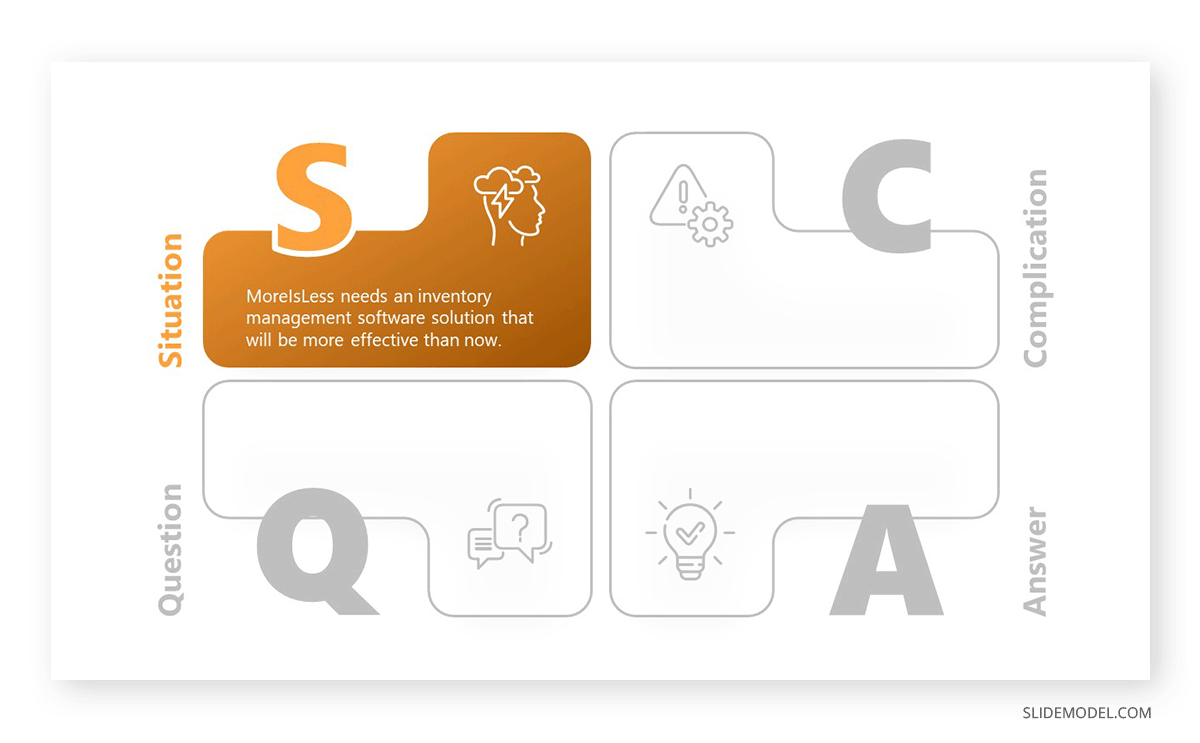
- Complication = Their current system creates bottlenecks in the supply chain, causing behavioral and financial problems. MoreIsLess managers are worried about disrupting operations to implement new management software. They are also worried about the software’s complexity.

- Question = How will TeachEase offer an inventory management solution that will solve the bottleneck issue quickly and efficiently without disrupting operations? How will they ensure timely employee training?

- Answer = TechEase offers to implement the new software over one weekend and train all involved employees within a week. Bottlenecks will ease within two weeks with a full-scale fix at three weeks max. The TechEase team also works with the customer success team to inform customers of the changes when necessary. They will offer a discount code to clients as an incentive if they have any issues in those two weeks.
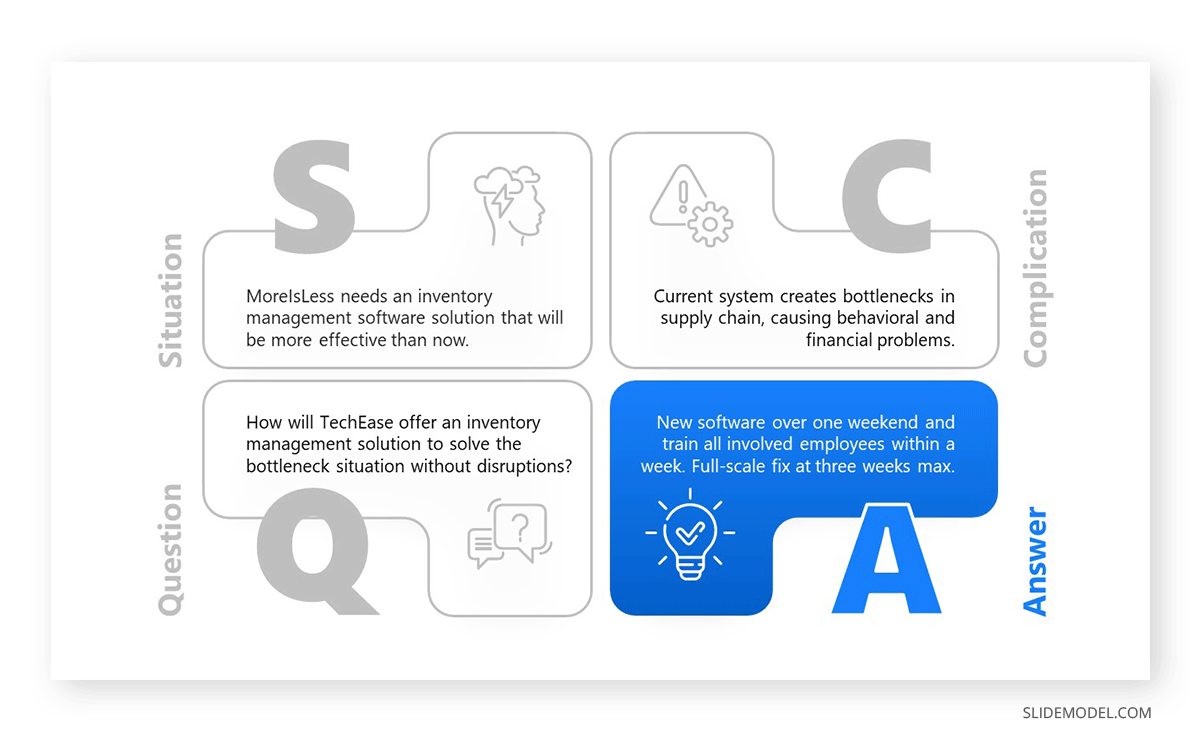
How Storytelling Enhances the Effectiveness of the Presentation
The story uses a visual metaphor, the bottleneck. In this case, a long-term inventory bottleneck with mistaken shipments and unsent orders is caused by the current software.
Ineffective inventory management software = a traffic bottleneck on a highway intersection
Everyone hates it when traffic becomes a bottleneck that makes drivers change routes, get lost, arrive late to their destination, etc. TechEase’s software solves the problem by creating more efficient inventory systems that relieve bottlenecks by “creating different lanes and making some of them wider.”
TechEase uses the bottleneck visual metaphor in the presentation slides by turning an inventory flowchart into a traffic bottleneck. In the following slides, the bottleneck eases up, and the presenter explains how the software solves that problem. During the conversation, they use analogies and metaphors that tie back to the idea of the traffic bottleneck.
Storytelling can be a powerful tool for persuasion. A well-crafted story can help the audience relate to the presenter’s point of view and see the value in a proposed solution, idea, or product. Using the bottleneck visual metaphor, TechEase connects with the audience in a plane beyond what they’re immediately discussing.
Finally, the TechEase team mentions a previous client with a similar issue. In a quick story, they explain how the software eased its bottlenecks without affecting daily productivity.
Tying the metaphoric story with a real story brings the idea home, from fiction to reality.
Resulting in MoreIsLess closing the deal and implementing TechEase’s software.
The Power of Visual Metaphors and Your Stories
Data and storytelling have many ways of working together to incentivize creative communication. One particular technique we’re fond of is visual metaphors and associations.
Relevant visual metaphors help you add storytelling to data without confusing the audience. It tends to do the opposite. Say you intend to represent what’s missing from a process to satisfy the customer’s needs. We can represent this situation as the following case study: a language learning application intends to compete on the same tier as top-industry solutions like Duolingo. They found out that users struggle to improve their pronunciation levels in some languages due to their way of pronouncing vocals and consonants in their native language. Take a look at this slide for a gap analysis. The broken road over a crevasse is the visual metaphor for the gap. It’s simple, it makes sense, and it’s effective. Using the gap analysis, the company can represent how the current state of their app is not helping users overcome pronunciation mistakes, as there’s no system to evaluate that in the app.
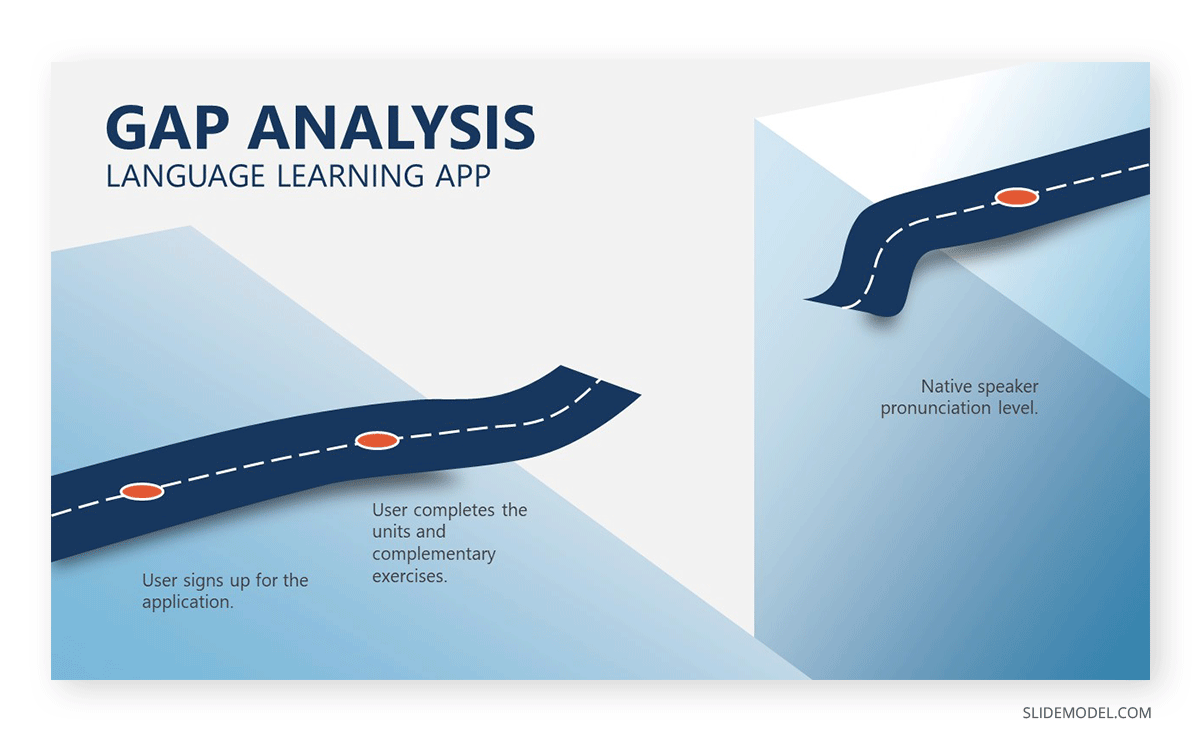
In another example, a company faces communication issues due to workers creating immense email threads due to the “Reply All” function. Instead of replying to the team members who should be aware of the answer, workers keep replying to all, creating email chains of over 20 emails that may not be relevant to the members listed in the initial email, as the current messages include specific instructions for one team. Instead, a wiser solution would be to reply only to those who find that communication pertinent or create a new email thread with the members interacting. Using the 3D square peg metaphor, we can represent how the “Reply All” option is forced into the organization rather than opting for individual email threads per topic or testing communication solutions like Microsoft Teams or Slack. This slide has an adaptable visual metaphor for explaining that something isn’t working as it should and that you’re forcing a solution where it isn’t fit to work.

The funnel is a classic and highly effective storytelling technique in marketing and business. We can drive the attention from hard-to-understand data into visual cues. Instead of using numbers to express how a media channel brings users to our company and turns them into prospective buyers, we can represent the funnel and categorize from contacts through the next filtered stage of qualified leads, then to prospects, and finally, opportunities. And we can also filter out the users who partially meet the criteria, reformulating solutions to their needs. Make yours unique by using colored dots, icons, and a legend to pinpoint where your team needs to work harder and what areas are strong.

As we’ve seen, there are multiple methods to implement metaphors to tell a story. The problem lies in pairing the aesthetic of your visual slides with the rest of the content you are delivering; otherwise, it feels disconnected. A tool like the SlideModel AI Presentation Maker help to bridge the gap by creating an entire slide deck based on a pre-selected design style and theme.
Overcoming Challenges in Storytelling for Corporate Presentations
There are always challenges and obstacles when using storytelling in corporate presentations. They’re the reason why so many presentations could have been emails. And also why deals aren’t closing, sales aren’t being made, and internal meeting presentations are unproductive. These are some of the most common:
- The company doesn’t have a brand story, no corporate storytelling strategy, nor does its communication culture have any stories to tell. This foments a culture of basic communication that doesn’t inspire action and growth.
- Everyone just keeps doing “what works.” When faced with something new, they say, “We’ve always been doing it this way.” If a new idea for a presentation comes up, they say, “We’ve used this report presentation template for the past year. Why change now?”
- It takes time to craft relevant stories and practice them. Many presentations must be finished fast and then presented at a meeting nobody wants to attend.
- Sometimes, a story used means nothing, and the effort is wasted.
Strategies For Overcoming Storytelling Challenges in a Corporate Setting
The number one strategy to overcome storytelling challenges is to understand and share that storytelling is worth the time it takes to implement.
Here are some strategies for overcoming storytelling challenges in a corporate setting.
- Develop a corporate storytelling strategy for your company. You can implement some of these solutions depending on your decision-making power in the company.
- Hire a brand storyteller to build a story from which the entire company can build more stories.
- Build detailed user personas and create stories around them.
- Hire a creative director to lead important presentation projects and client communication.
- Challenge your employees to get creative when building presentations and think of other ideas to implement instead of reusing the same report template every Friday. If your company has a brand story, share it with them. Involve the Learning and Development department and offer storytelling workshops for everyone to build their skills.
- Don’t create a story for each presentation. Keep a folder of potential stories to use in the future and reference it regularly.
- Make the stories mean something. Stories that don’t relate to your audience are as good as nothing.
Be ready for every situation; you never know when your in-person presentation will turn into a hybrid session at the last minute. If you practiced a presentation for a stage, with some walking around and eye contact, you’ll have to bring it all in and adapt it for the camera.
In a few steps, you can adapt the storytelling from an in-person meeting into a hybrid session.
- Set up a camera to record the front of the room where the presenters will be.
- Connect it to the webinar or meeting software and test it.
- Send attendees a digital copy of the presentation slides.
- When the session starts, don’t just show the front of the room to the virtual attendees; change views and show the slides fullscreen, especially those with the visual metaphor.
- During the session, have someone in charge of the chat box and motivate attendees to participate in the discussion.
Conclusion
The power of storytelling is undisputed. It differentiates between a presentation considered “this could have been an email” and a presentation that positively impacts the audience.
Stories in a corporate setting are the glue that humanizes business meetings, making them more entertaining, effective, compelling, memorable, and successful.
In this guide, we shared some storytelling techniques you can incorporate at different levels of your organization. Try them out and see what works better. Part of getting to know your audience is trying out stories with them and seeing how they react. Check out our storytelling templates for PowerPoint to create your next presentation.
Here’s to much better presentations in your future.
Sources
Zacks, J. M., Speer, N. K., & Reynolds, J. R. (2009). Segmentation in reading and film comprehension. Journal of Experimental Psychology: General, 138(2), 307–327. https://doi.org/10.1037/a0015305
Source: Zak, P. J. (2014). Why inspiring stories make us react: The neuroscience of narrative. Cerebrum: The Dana Forum on Brain Science, 2014, 2. Retrieved from https://www.ncbi.nlm.nih.gov/pmc/articles/PMC4445577/
Green, M. C., & Brock, T. C. (2000). The role of transportation in the persuasiveness of public narratives. Journal of Personality and Social Psychology, 79(5), 701–721. https://doi.org/10.1037/0022-3514.79.5.701
Hinyard, L. J., & Kreuter, M. W. (2007). Using narrative communication as a tool for health behavior change: A conceptual, theoretical, and empirical overview. Health Education & Behavior, 34(5), 777–792. https://doi.org/10.1177/1090198106291963


